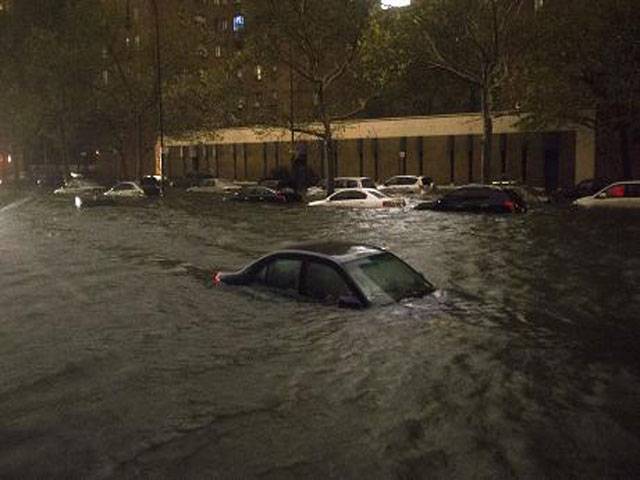The fury of "Frankenstorm" plunged New York into darkness, desperation and panic.
Superstorm Sandy left the the Wall Street financial district and the rest of lower Manhattan without power and no firm idea when the lights will be turned on again.
The streets, many waist deep in floodwater, were eerily quiet after the storm, with the only sound coming from distant sirens and the only light cast by candles in apartment windows and the blue and red flashes of police cars.
"It's kind of scary. There is no light in the street, no people in the street," said Ilona, a 22-year-old student from Russia, as she looked out over the murky water.
Even the traffic lights were out. Special generator trucks were ordered in, and authorities reopened the George Washington bridge so some could be driven in from neighboring New Jersey.
"We have been sent to provide power for buildings and answer the 911 emergency calls," the driver of one generator truck said.
Desperate owners sought to check on businesses, apartments and cars.
Olatz Schnabel, the former companion of the artist Julian Schnabel, rushed with her two sons to check whether her decoration shop had been flooded.
"The water did not get that far. We managed to get everything out of the cellar," she said.
But there was devastation, as floodwater poured into the city from the East River, inundating road tunnels and subway stations and threatening several days of transport chaos.
On the West Side Highway, the Goldman Sachs bank was one of the few buildings still lit up, the streets and sidewalks below flooded with water.
At the 148th Street station in Harlem, a thick layer of garbage floated on the filthy water that covered the platforms. Workers stared forlornly at the devastation, hardly knowing where to start the cleanup.
"It's disgusting, and it always seems to happen here," said Ryan Gambill as he waited at the entrance.
The panic came from not knowing the final toll.
One man was confirmed dead, crushed by a falling tree in the Queens borough.
But rescue operations were launched on Staten Island, at Rockaway Beach and Coney Island, seafront districts where many residents had ignored pleas to move to safety, and where some houses were said to be flooded almost to their roofs.
Waves from the storm tore up the wooden beach boardwalk at Coney Island and nearby Brighton Beach, weekend resorts for New York's working class. Cars floated in the water at Long Beach.
Police appealed for boats to conduct rescue missions in Staten Island and at Coney Island in Brooklyn.
"I am seriously concerned for people's lives," said Vincent Ignizio, a New York City councilman from Staten Island.
Tuesday, April 16, 2024
New York plunged into darkness and despair

Pakistan, IMF discussing new multi-billion-dollar program, says Finance Minister Aurangzeb
11:09 AM | April 16, 2024
LESCO ‘bars’ officers from appearing before FIA in overbilling probe
10:49 AM | April 16, 2024
Aleem Khan, Kamran Tessori discuss matters of mutual interests
10:40 AM | April 16, 2024
Global brands facing challenge from local contenders in Pakistan's FMCG market
10:24 AM | April 16, 2024
Israeli Air Force finalizes preparations for possible attack on Iran
8:21 AM | April 16, 2024
Political Reconciliation
April 16, 2024
Pricing Pressures
April 16, 2024
Western Hypocrisy
April 16, 2024
Policing Reforms
April 15, 2024
Storm Safety
April 15, 2024
Democratic harmony
April 16, 2024
Digital dilemma
April 16, 2024
Classroom crisis
April 16, 2024
Bridging gaps
April 16, 2024
Suicide awareness
April 15, 2024
ePaper - Nawaiwaqt
Advertisement
Nawaiwaqt Group | Copyright © 2024





